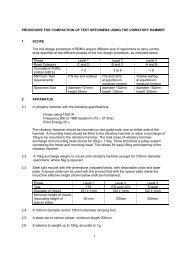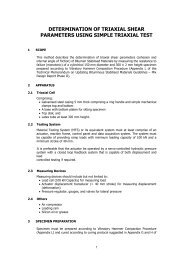Method 2. Determining Foam Characteristics of ... - Asphalt Academy
Method 2. Determining Foam Characteristics of ... - Asphalt Academy
Method 2. Determining Foam Characteristics of ... - Asphalt Academy
- No tags were found...
You also want an ePaper? Increase the reach of your titles
YUMPU automatically turns print PDFs into web optimized ePapers that Google loves.
THE DETERMINATION OF THE FOAMING CHARACTERISTICS OF BITUMEN<br />
1. SCOPE<br />
The foaming characteristics <strong>of</strong> bitumen are defined by the Expansion Ratio and Half Life <strong>of</strong><br />
the bitumen in its expanded state. The expanded state <strong>of</strong> the bitumen is achieved when a<br />
small percentage <strong>of</strong> water is introduced into hot bitumen.<br />
The objective is to determine the percentage <strong>of</strong> water required that will produce the best<br />
foam characteristics for a particular source <strong>of</strong> bitumen. The aim is to produce foamed<br />
bitumen with the largest expansion ratio with the longest half-life possible.<br />
<strong>2.</strong> DEFINITIONS<br />
The expansion ratio is a measure <strong>of</strong> the viscosity <strong>of</strong> the foam and provides an indication <strong>of</strong><br />
how well the binder will disperse in the mix. It is calculated as the ratio <strong>of</strong> the maximum<br />
volume <strong>of</strong> foam relative to the original volume <strong>of</strong> bitumen.<br />
The half-life is a measure <strong>of</strong> the stability <strong>of</strong> the foam and provides an indication <strong>of</strong> the rate<br />
<strong>of</strong> collapse <strong>of</strong> the foam during mixing. It is calculated as the time taken in seconds for the<br />
foam to collapse to half <strong>of</strong> its maximum volume.<br />
3. APPARATUS<br />
3.1 <strong>Foam</strong>ed Bitumen Laboratory Unit, capable <strong>of</strong> producing foamed bitumen at a rate <strong>of</strong><br />
between 50g and 200g per second. The method <strong>of</strong> production shall closely simulate that <strong>of</strong><br />
full scale production <strong>of</strong> foamed bitumen on the recycling machine. The apparatus shall<br />
have a thermostatically controlled kettle capable <strong>of</strong> holding a mass <strong>of</strong> 10kg <strong>of</strong> bitumen at a<br />
constant temperature between the range <strong>of</strong> 160ºC and 200ºC, ± 5ºC. The unit shall have<br />
an expansion chamber similar to that on the recycling machine in which cold water is<br />
injected into hot bitumen. Water injection shall be variable from 0 to 5% (by mass <strong>of</strong> the<br />
bitumen) with an accuracy <strong>of</strong> 0.25%. The plant shall capable <strong>of</strong> accurately discharging a<br />
predetermined mass <strong>of</strong> foamed bitumen directly into the mixing bowl <strong>of</strong> an electrically driven<br />
laboratory mixer with a minimum capacity <strong>of</strong> 10kg.<br />
3.2 Cylindrical metal container, 250mm diameter<br />
and at least 20 litre capacity.<br />
3.3 Calibrated Dip Stick, calibrated for the cylindrical<br />
metal container with 500g <strong>of</strong> bitumen as 1 unit<br />
measure. Prongs are attached to the dip stick at<br />
every 5 or 6 times the unit volume.<br />
3.4 A stop-watch with 60 second dial.<br />
3.5 Heat resistant gloves.<br />
3.6 An electronic balance to weigh up to 10kg,<br />
accurate to 1g.<br />
1
4. METHOD<br />
4.1 Preparation<br />
The foamed bitumen laboratory unit discharge rates are checked in accordance with the<br />
manufactures specifications. If the unit is being used for the first time then the pump rate<br />
and water flow rates need to be calibrated as per the manufactures specifications. Check<br />
that 500g <strong>of</strong> bitumen is being discharged at the predetermined settings.<br />
Ensure that the cylindrical metal container and dip stick are reasonably clean. Discharge<br />
foamed bitumen, at least twice, into cylindrical metal container prior to testing in order to<br />
pre-heat the container. Decant excess bitumen from the container into a suitable waste<br />
receptacle.<br />
5. Testing<br />
Heat the bitumen in the kettle <strong>of</strong> the foamed bitumen laboratory unit with the pump<br />
circulating the bitumen through the system until the required temperature is achieved<br />
(normally starting with 160 °C). Maintain the required temperature for at least 5 minutes<br />
prior to commencing with testing.<br />
Set the water flow-meter to achieve the required water injection rate (normally starting with<br />
2 % by mass <strong>of</strong> the bitumen).<br />
Discharge foamed bitumen into the preheated steel drum for the calculated spray time for<br />
500 g <strong>of</strong> bitumen. Immediately after the foamed bitumen discharge stops, start a stopwatch.<br />
Using the calibrated dipstick measure the maximum height the foamed bitumen achieves in<br />
the drum. This maximum volume is recorded as the expansion.<br />
Continue to measure the time in seconds that the foam takes to dissipate to half <strong>of</strong> its<br />
maximum volume. This is recorded as the foamed bitumen’s half-life.<br />
Repeat the above procedures three times or until similar readings are achieved.<br />
The expansion and half life are determined at different percentages <strong>of</strong> water. Typically,<br />
values <strong>of</strong> 2 %, 3 % and 4 % by mass <strong>of</strong> bitumen are used.<br />
Plot a graph <strong>of</strong> the expansion ratio versus half-life at the different water injection rates on<br />
the same set <strong>of</strong> axes. The optimum water addition is chosen as an average <strong>of</strong> the two water<br />
contents required to meet the minimum criteria.<br />
If the required properties are not met at 160 o C, further testing should be carried out with the<br />
bitumen at higher temperatures (typically 170 o C and 180 o C).<br />
2
6. Reporting<br />
The foamed bitumen characteristics and optimum water content are reported as;<br />
Optimum water content (%) Percentage by mass <strong>of</strong> bitumen;<br />
Expansion (times)<br />
Ratio <strong>of</strong> maximum expansion to original volume <strong>of</strong> bitumen;<br />
Half life (sec) Time taken from maximum expansion to half this volume.<br />
3












